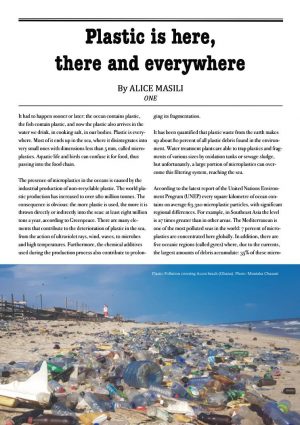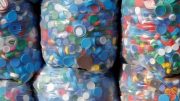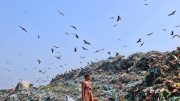 It had to happen sooner or later: the ocean contains plastic, the fish contain plastic, and now the plastic also arrives in the water we drink, in cooking salt, in our bodies. Plastic is everywhere. Most of it ends up in the sea, where it disintegrates into very small ones with dimensions less than 5 mm, called microplastics. Aquatic life and birds can confuse it for food, thus passing into the food chain.
It had to happen sooner or later: the ocean contains plastic, the fish contain plastic, and now the plastic also arrives in the water we drink, in cooking salt, in our bodies. Plastic is everywhere. Most of it ends up in the sea, where it disintegrates into very small ones with dimensions less than 5 mm, called microplastics. Aquatic life and birds can confuse it for food, thus passing into the food chain.
The presence of microplastics in the oceans is caused by the industrial production of non-recyclable plastic. The world plastic production has increased to over 280 million tonnes. The consequence is obvious: the more plastic is used, the more it is thrown directly or indirectly into the seas: at least eight million tons a year, according to Greenpeace. There are many elements that contribute to the deterioration of plastic in the sea, from the action of ultraviolet rays, wind, waves, to microbes and high temperatures. Furthermore, the chemical additives used during the production process also contribute to prolonging its fragmentation.
It has been quantified that plastic waste from the earth makes up about 80 percent of all plastic debris found in the environment. Water treatment plants are able to trap plastics and fragments of various sizes by oxidation tanks or sewage sludge, but unfortunately, a large portion of microplastics can overcome this filtering system, reaching the sea.
According to the latest report of the United Nations Environment Program (UNEP) every square kilometre of ocean contains on average 63.320 microplastic particles, with significant regional differences. For example, in Southeast Asia the level is 27 times greater than in other areas. The Mediterranean is one of the most polluted seas in the world: 7 percent of microplastics are concentrated here globally. In addition, there are five oceanic regions (called gyres) where, due to the currents, the largest amounts of debris accumulate: 35% of these micro-fragments of plastic come from the washing of our clothing; the synthetic garments, which today represent 60% of global textile consumption, release large quantities of fibres, which from the domestic discharge pass into the purifiers, contaminating the food chain. According to the FAO (United Nations Food Fund) and the International Cotton Advisory Committee, consumption of synthetic fibres increased by 300% between 1992 and 2010. At the moment there are no complete scientific data on the exact quantity of microplastics that, from our sweaters or jeans, end up in the waters of the rivers after washing. But the available data are alarming.
A research directed by Mark Browne of the University College of Dublin in 2011 showed how a single garment can release more than 1,900 microfibres in a wash. A study by the University of Plymouth published in 2016 compared different fabrics and analysed a series of washing variables. Although not having obtained clear results with respect to the type of detergent and the addition or less of fabric softener, it emerged that, from the fully synthetic garments, more microfibers are detached: on a load of 6 kilograms, in fact, garments in mixed cotton and polyester fabrics releasing almost 138 thousand fibres, against over 496 thousand of the polyester and almost 729 thousand of the acrylics. Faced with this data, some large groups of clothing are trying to remedy before Europe set some limits.
Another significant source of microplastic particles is the wear and tear of tyres, the outer part of which consists of synthetic polymers mixed with rubber and other additives. The plastic fibres, released in the environment, are transported in marine environments by the action of wind and rains. Other plastics are intentionally designed to be small. They are called microspheres and are used in many products for health and beauty. Unchanged, they pass through the waterways in the oceans and are responsible for 2% of the total fragments.
Once at sea these substances are ingested by the fauna (in particular plankton, invertebrates, fish, gulls, sharks and whales) entering the food chain. In 2015, a first study showed the presence of microplastic in fifteen different types of salt in China.
But if you think that the microplastics are found only in the oceans and in the fish, you wrong. Researchers at the Medical University of Vienna and the Austrian Environmental Agency have found that microplastic particles are present in human stool samples and in the gastrointestinal area, where they can promote transmission of pathogens or harmful chemicals to our body. The research, conducted on eight subjects, showed how everyone had eaten foods wrapped in plastic materials, as well as drinking water from still plastic bottles.
The research has been opposed by some scholars, who consider the data very limited. The biologist Martin Wagner of the Norwegian University of Science and Technology has indeed stated that the scale is small and not representative, therefore not reliable. Meanwhile, politics is moving with several laws that each state has introduced to solve the problem. Since 2015, combating marine pollution is one of the objectives of sustainable development (Sustainable development goals, SDG).
In December 2015, then-President Barack Obama signed the law prohibiting the intentional addition of small plastic balls in some cosmetics, such as toothpaste and skin creams. Although this law does not include all cosmetics, it has inspired other laws around the world. In fact, the United Kingdom has introduced the same ban by extending it even on adding microplastics to all cosmetic products. Italy has banned non-biodegradable cotton buds and has recently introduced the use of biodegradable bags in all commercial activities. On this, Ireland was one of the first European countries, introducing in 2002 a tax for each bag sold. Same measure adopted by Wales, Belgium and Denmark.
During the plenary meeting of 16 January 2018 in the European Parliament in Strasbourg, the European Commission presented its strategy to combat plastic waste. It establishes that all plastics packaging in the EU will need to be recyclable by 2030, the addition of microplastics is prohibited in all products and new legislation is proposed to limit single-use plastic consumption. The goal is to increase the recourse to reuse – which today is only 30 percent of the total in the continent – and reduce the use of microplastics.
China, the largest plastic recycler in the world, has closed its doors to the importation of plastic from the rest of the world to focus on the one produced internally. Among the countries that have banned the use of plastic bags in the world, there are many African countries such as South Africa, Eritrea, Rwanda and more recently Kenya. Even India, where the problem of plastic fuels illegal fires, has banned the production of disposable plastic for about a year.
Alice Masili





